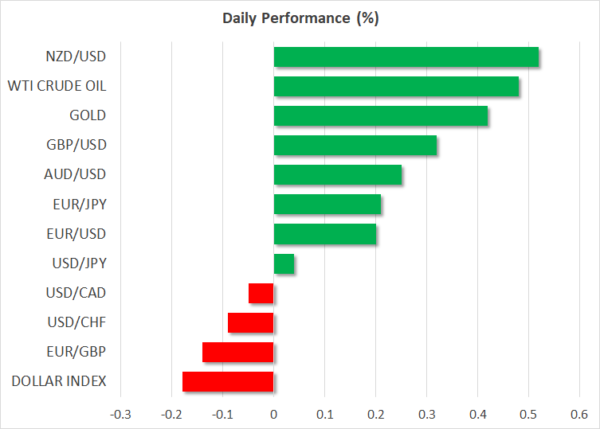- Mood improves, helped by signs that Biden’s fiscal agenda isn’t dead
- Dollar pulls back, sterling recovers in a relatively quiet FX market
- Stocks and oil prices bounce back, Turkish lira stages epic comeback
Risk sentiment stabilizes
Global markets started the week on a soft note amid worries that the lightning-fast spread of Omicron would curtail economic growth at a time when central bank liquidity is evaporating and government spending is rolled back. Thin trading volumes because of the holiday season likely acted as an accelerant for the sell-off.
The good news is that the bleeding has stopped for now. Asian and European shares have bounced back, Wall Street futures point to a positive open today, and oil prices have stabilized alongside most commodity currencies. It is worth noting that the S&P 500 rebounded off its 100-day moving average yet again.
What calmed the market’s nerves isn’t entirely clear, although some signs that President Biden’s fiscal agenda isn’t completely dead likely helped. Senator Manchin’s stark refusal to support the social package was interpreted as a fatal blow to the Democrats’ spending program, but it seems the negotiations will continue next year after all.
Dollar cools, sterling breathes
The FX arena has been remarkably stable considering the heightened volatility elsewhere, with most major currency pairs trading without a clear direction. Dollar/yen has been the epitome of this relative tranquility, thanks to the defensive qualities of both the greenback and the yen.
In contrast, sterling has been in the eye of the storm, caught between the Bank of England’s surprise rate increase and the wild shifts in risk appetite. The prospect of stricter restrictions to battle Omicron before Christmas is also lurking in the background, preventing the pound from staging a proper comeback.
Looking ahead, the key themes for the currency market next year will be central bank policies and how risk sentiment evolves. This is a recipe for higher volatility as FX traders will have to grapple with inflation surprises and any panic episodes in markets, which could become more frequent as liquidity gets withdrawn from the system.
For now, the risk is some flash crash happening in a very illiquid holiday market.
Turkish lira fights back
The Turkish lira has been all the rage lately, with central bank rate cuts in the face of accelerating inflation bringing the currency to its knees, until local authorities signaled they’ve had enough yesterday. The government said it will protect the holders of lira deposits, compensating them for FX losses that exceed interest rates offered by banks.
Of course, there are many questions about whether this program would exacerbate inflationary pressures and how it would be funded, something reflected in derivatives markets signaling a higher risk of default on Turkish debt. But as far as stopping the lira’s freefall, it has worked wonders, with the currency recovering 15% of its value as the psychological signal alone sparked a short squeeze of epic proportions.
The economic calendar is low key. The spotlight will fall on Canada’s retail sales after a rough couple of months for the loonie, which has been trading in lockstep with struggling oil prices. Overall, markets will continue to take their cue from any news around Omicron, central banks, and the US fiscal agenda.













